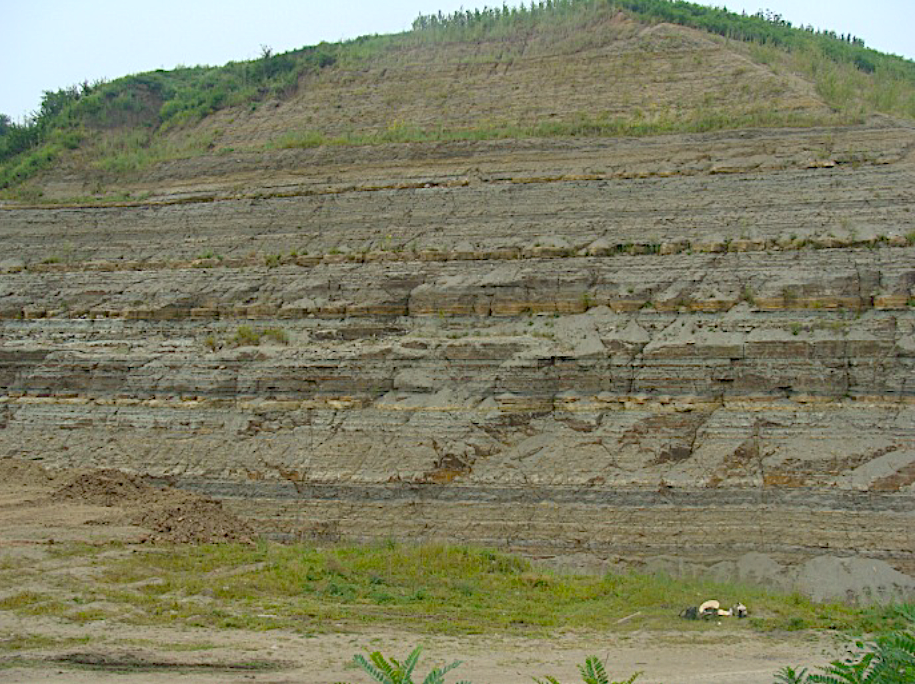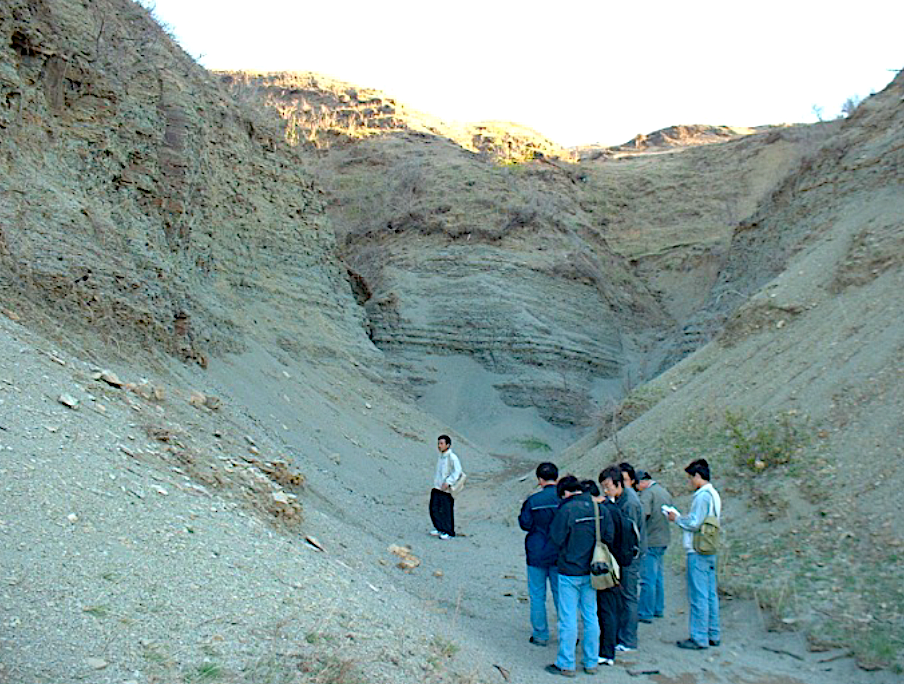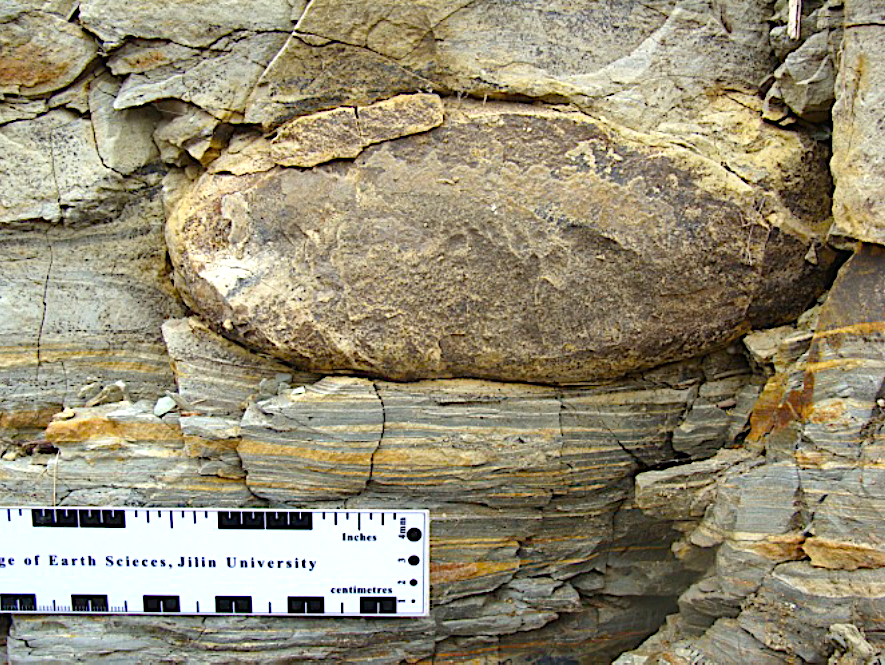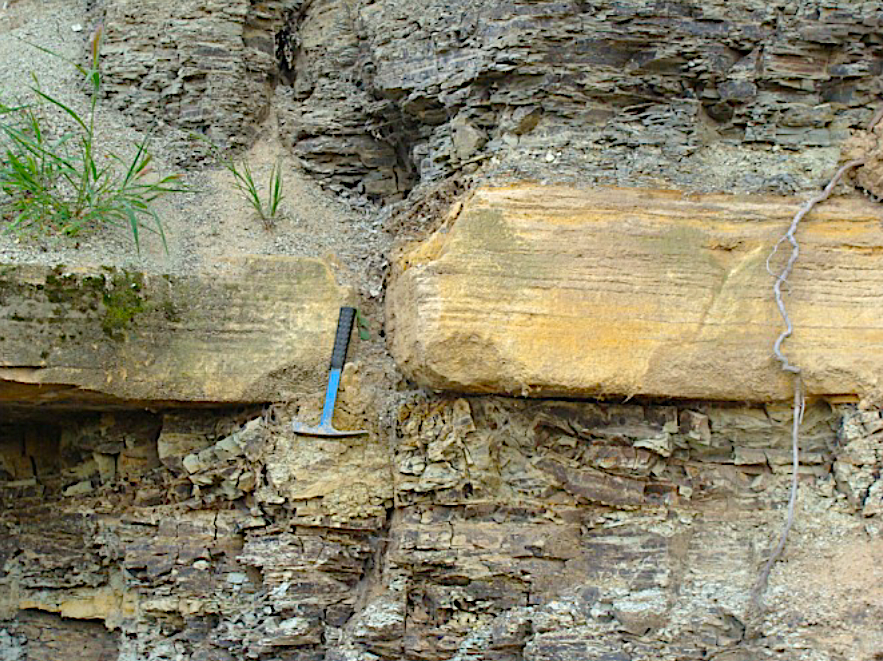Nenjiang Fm
Type Locality and Naming
Songliao Basin. Tan Xichou and Wang Huansheng erected the Nenjiang shale series. The section for the designation is to the east of the Jiangjia Village of northwest Nenjiang County, Heilongjiang. The reference section is down the borehole No.25 at the Zheng Defu Village of Guangrong township of the Zhaozhou County, Heilongjiang. Upper-middle formation (5 of 7) in the Songhuajiang Gr.
Lithology and Thickness
The Nenjiang Formation is mainly represented by gray black mudstone and shale, intercalated with white and gray green siltstone and fine sandstone, with red claystone appearing in its upper part. It has been divided in ascending order into five members. First member is built up by gray black muddy shale with silty mudstone and thin-bedded oil shale and shale; Second member is gray black clayey shale interbedded with gray silty claystone, with an oil shale bed of more than 20 m thick serving as a marker bed for regional correlation; Third member is gray black mudstone and silty mudstone in the lower part and gray white fine sandstone, gray green clayey siltstone and silty mudstone in the upper part, constituting reversed cycle which is from coarse to fine from below upward; Fourth member is gray green mudstone and silty mudstone interbedded with gray white fine sandstone of different thicknesses; Fifth member is gray white fine sandstone and brown red and gray brown silty mudstone and mudstone. The formation is 1010.4 m thick and is a major oil-bearing formation in the Songliao basin.
[Figure: Members 1-2 of Nenjiang Formation at Houjingou section in Nongan City, Jilin Province]
[Figure: Lower part of Nenjiang Formation by second Songhua river bridge of the Dehui City of Jilin]
[Figure: Dolomite nodule in Nenjiang Formation of Dehui City]
[Figure: Ostracod limestone bed in Nenjiang Formation of Dehui City]
Relationships and Distribution
Lower contact
The base of the formation marked by gray black clayey shale lies disconformably on the underlying Yaojia Fm.
Upper contact
The top is marked by brown red sandy mudstone underlies unconformably on the variegated massive mudstone of the overlying Sifangtai Fm.
Regional extent
The Nenjiang Formation is widespread in the Songliao basin and is mostly covered. It is developed quite completely in the central and eastern parts of the basin and its outcrops are seen in the Beian, Hailun and Nenjiang counties of Heilongjiang, and the Nongan, Qianguoqi, Huaide and Dehui counties of Jilin, and around the second Songhuajiang River. It has been mostly disintegrated due to the late stage uplifting in Hailun, Tieli and Lalin on the east margin of the Heilongjiang basin; and the fifth member is missing in the northern and western parts of the basin; and the first and second members are only seen in the Taikang area. It is 500-1000 m in the central part of the basin; more than 1000 m in the Sanzhao depression, Daqing and Gulong; 504-645 m in the eastern part of the basin, generally 170-400 m in the western part; 535 m in the Wuyuer area, quite thin just less than 140 m to the west of Hulan Ergi. The first and second members are fine in the central part of the basin and there appear sandstone partings towards east and in the northern and western parts there occur clayey shale interbedded with sandstone. The fourth member is intercalated with red clastic rocks throughout the basin, except in the central part. The fifth member is distributed in Suihua and Taipingchuan of the Zhaodong County in the central and eastern parts of the basin, represented by brownish red and grayish green mudstone and silty mudstone and grayish white and brownish red sandstone. In the Nenjiang and Dedu areas of northern basin, the Nenjiang Formation overlaps the strata prior to the Mesozoic.
GeoJSON
Fossils
The formation bears ostracods Cypridea ordinata, C. gunsulinensis, C. tera, Strumosia inandita, Ilyocyprimorpha sungarinensis, Ziziphocypris simakovi; bivalves Sphaerium shantungensis, S. fulungchanensis; down the borehole No.qi-6 estheria Palaeolimnadiopsis anguangensis; down the borehole No.qi-23 Pisces Manchurichthys sp.; down the borehole No.fu-8 Sungarichthys longicaphalus; down the borehole No.sui-4 floras Trapa? microphylla; down the borehole No.ji-15 sporopollen grains represented by the Balmeisporites-Lythraites- Aquilapollenites assemblage. Some foraminifera tests were recovered from the samples of lower Nenjiang Formation. Beyond benthic taxa, planktonic species are Archaeoglobigerina blowi, A. cretacea, and Hedbergella flandrini.
Age
Depositional setting
It is marked by deep lake and semi-deep lake deposition during early and middle stage and by shallow lake facies deposition during late time. The foraminifera fauna in the Nenjiang Formation is a typical marine fauna, which indicate that sea water invaded in to the Songliao basin during late Coniacian to early Santonian times.
Additional Information



